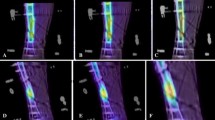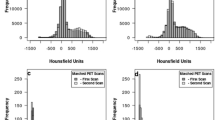Abstract
Purpose
The Taylor Spatial Frame (TSF) is used to correct orthopedic conditions such as correction osteotomies in delayed fracture healing and pseudarthrosis. Long-term TSF-treatments are common and may lead to complications. Current conventional radiological methods are often unsatisfactory for therapy monitoring. Hence, an imaging technique capable of quantifying bone healing progression would be advantageous.
Methods
A cohort of 24 patients with different orthopedic conditions, pseudarthrosis (n = 10), deformities subjected to correction osteotomy (n = 9), and fracture (n = 5) underwent dynamic [18F]-fluoride (Na18F) PET/CT at 8 weeks and 4 months, respectively, after application of a TSF. Parametric images, corresponding to the net transport rate of [18F]-fluoride from plasma to bone, K i were calculated. The ratio of the maximum K i at PET scan 2 and 1 (\( {\overline{K}}_{i, \max } \)) as well as the ratio of the maximum Standard Uptake Value at PET scan 2 and 1 (\( {\overline{SUV}}_{\max } \)) were calculated for each individual. Different treatment end-points were scored, and the overall treatment outcome score was compared with the osteoblastic activity progression as scored with \( {\overline{K}}_{i, \max } \) or \( {\overline{SUV}}_{\max } \).
Results
\( {\overline{K}}_{i, \max } \) and \( {\overline{SUV}}_{\max } \) were not correlated within each orthopedic group (p > 0.1 for all groups), nor for the pooled population (p = 0.12). The distribution of \( {\overline{K}}_{i, \max } \) was found significantly different among the different orthopedic groups (p = 0.0046) -also for \( {\overline{SUV}}_{\max } \) (p = 0.022). The positive and negative treatment predictive values for \( {\overline{K}}_{i, \max } \) were 66.7 % and 77.8 %, respectively. Corresponding values for \( {\overline{SUV}}_{\max } \) were 25 % and 33.3 %
Conclusions
The \( {\overline{K}}_{i, \max } \) obtained from dynamic [18F]-fluoride-PET imaging is a promising predictive factor to evaluate changes in bone healing in response to TSF treatment.




Similar content being viewed by others
References
Charles JT. Correction of general deformity with the Taylor Spatial Frame fixator. General TSF literature. 2002. http://www.jcharlestaylor.com/tsfliterature/01TSF-mainHO.pdf Accessed 21 Dec 2015.
Tan B, Shanmugam R, Gunalan R, Chua Y, Hossain G, Saw A. A biomechanical comparison between Taylor’s Spatial Frame and Ilizarov external fixator. Malays Orthop J. 2014;8:35–9.
Rozbruch SR, Segal K, Ilizarov S, Fragomen AT, Ilizarov G. Does the Taylor spatial frame accurately correct tibial deformities? Clin Orthop Relat Res. 2010;468:1352–61.
Kuhlman JE, Fishman EK, Magid D, Scott Jr WW, Brooker AF, Siegelman SS. Fracture nonunion: CT assessment with multi-planar reconstruction. Radiology. 1988;167:483–8.
Bockisch A, Beyer T, Antoch G, Freudenberg LS, Kühl H, Debatin JF, et al. Positron emission tomography/computed tomography--imaging protocols, artifacts and pitfalls. Mol Imaging Biol. 2004;6:188–99.
Schäfers K, Raupach R, Beyer T. Combined 18F-FDG-PET/CT imaging of the head and neck: an approach to metal artifact correction. Nuklearmedizin. 2006;45:219–22.
Hsu WK, Feeley BT, Krenek L, Stout DB, Chatziioannou AF, Lieberman JR. The use of 18F-fluoride and 18F-FDG PET scans to assess fracture healing in a rat femur model. Eur J Nucl Med Mol Imaging. 2007;34:1291–301.
Blake GM, Park-Holohan SJ, Fogelman I. Quantitative studies of bone in postmenopausal women using 18F-fluoride and 99mTc-methylene diphosphonate. J Nucl Med. 2002;43:338–45.
Installé J, Nzeusseu A, Bol A, Depresseux A, Devogelaer JP, Lonneux M. 18F-fluoride PET for monitoring therapeutic response in Paget’s disease of bone. J Nucl Med. 2005;46(10):1650–8.
Messa C, Goodman WG, Hoh CK, et al. Bone metabolic activity measured with positron emission tomography and [18F]-fluoride ion in renal osteodystrophy: correlation with bone histomorphometry. J Clin Endocrinol Metab. 1993;77:949–55.
Piert M, Zittel TT, Becker GA, et al. Assessment of porcine bone metabolism by dynamic [18F]-fluoride ion PET: correlation with bone histomorphometry. J Nucl Med. 2001;42:1091–100.
Hawkins RA, Choi Y, Huang SC, Hoh CK, Dahlbom M, Schiepers C, et al. Evaluation of the skeletal kinetics of fluorine-18-fluoride ion with PET. J Nucl Med. 1992;33:633–42.
Segall G, Delbeke D, Stabin MG, Even-Sapir E, Fair J, Sajdak R, et al. SNM practice guideline for sodium 18F-fluoride PET/CT bone scans 1.0. J Nucl Med. 2010;51:1813–20.
Brenner W, Vernon C, Muzi M, Mankoff DA, Link JM, Conrad EU, et al. Comparison of different quantitative approaches to 18F-fluoride PET scans. J Nucl Med. 2004;45:1493–500.
Doot RK, Muzi M, Peterson LM, Schubert EK, Gralow JR, Specht JM, et al. Kinetic analysis of18F-fluoride PET images of breast cancer bone metastases. J Nucl Med. 2010;51:521–7.
Patlak CS, Blasberg RG, Fenstermacher JD. Graphical evaluation of blood-to-brain transfer constants from multiple-time uptake data. J Cereb Blood Flow Metab. 1983;3:1–7.
Hatherly R, Brolin F, Oldner Å, Sundin A, Lundblad H, Maguire Jr GQ, et al. Technical requirements for Na18F PET bone imaging of patients being treated using a Taylor spatial frame. J Nucl Med Technol. 2014;42:33–6.
Wen L, Eberl S, Dagan Feng D, Stalley P, Huang G, Fulham MJ. Parametric images in assessing bone grafts using dynamic 18F-Fluoride PET. Int J Mol Imaging. 2011;2011, 189830.
Blomqvist G. On the construction of functional maps in positron emission tomography. J Cereb Blood Flow Metab. 1984;4:629–32.
Sanchez-Crespo A. Comparison of Gallium-68 and Fluorine-18 imaging characteristics in positron emission tomography. Appl Radiat Isot. 2013;76:55–62.
Boellaard R, Delgado-Bolton R, Oyen WJ. FDG PET/CT: EANM procedure guidelines for tumour imaging: version 2.0. Eur J Nucl Med Mol Imaging. 2015;42(2):328–54.
Temmerman OP, Raijmakers PG, Kloet R, Teule GJ, Heyligers IC, Lammertsma AA. In vivo measurements of blood flow and bone metabolism in osteoarthritis. Rheumatol Int. 2013;33(4):959–63.
Blake GM, Frost ML, Fogelman I. Quantitative radionuclide studies of bone. J Nucl Med. 2009;50(11):1747–50.
Blake GM, Siddique M, Frost ML, Moore AE, Fogelman I. Radionuclide studies of bone metabolism: do bone uptake and bone plasma clearance provide equivalent measurements of bone turnover? Bone. 2011;49(3):537–42.
Author information
Authors and Affiliations
Corresponding author
Ethics declarations
Conflict of interest
A. Sanchez-Crespo declares that he has no conflict of interest.
F. Christiansson declares that he has no conflict of interest.
C. K. Thur declares that she has no conflict of interest.
H. Lundblad declares that he has no conflict of interest.
A. Sundin declares that he has no conflict of interest.
Ethical approval
All procedures performed in this work involving human participants were in accordance with the ethical standards of the institutional and/or national research committee and with the 1964 Helsinki Declaration and its later amendments or comparable ethical standards.
Informed consent
Informed consent was obtained from all individual participants included in the study.
Rights and permissions
About this article
Cite this article
Sanchez-Crespo, A., Christiansson, F., Thur, C.K. et al. Predictive value of [18F]-fluoride PET for monitoring bone remodeling in patients with orthopedic conditions treated with a Taylor spatial frame. Eur J Nucl Med Mol Imaging 44, 441–448 (2017). https://doi.org/10.1007/s00259-016-3459-5
Received:
Accepted:
Published:
Issue Date:
DOI: https://doi.org/10.1007/s00259-016-3459-5




